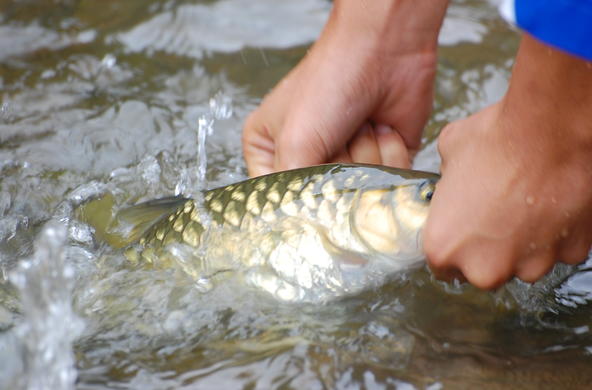Did you know some fish are made of maple leaves?
Organisms living in lakes rely, in part, on food supplied by watersheds. Tree leaves, pine needles, and dissolved bits of plant matter made of carbon enter lakes via runoff and inputs from streams and groundwater. This land-based carbon feeds plankton – the base of the aquatic food web.
We are looking at how shoreline alterations, watershed development, and climate change impact the amount of terrestrial carbon entering lakes, and what these changes mean for lake water quality and the health of fish populations.
The problem
- Watershed and shoreline disturbance increases the amount of land-grown carbon entering lakes.
- While these inputs can feed aquatic life, they also impact light penetration, water clarity, water temperature, and carbon cycling.
- Management decisions and climate change limit the amount of carbon lakes can store.
- Less carbon trapped in lakes means more carbon in the atmosphere – which exacerbates climate change and its effects.
We are exploring...
- How human activities and climate change influence carbon cycling and storage in lakes
- If there is a tipping point at which inputs of land-based carbon harm lake life
Our discoveries
While it has been recognized that animals living at the bottom of lakes rely, in part, on carbon inputs from the land, Cary scientists were among the first to reveal that open-water animals, such as zooplankton, also consume this material.
We were part of an international team that analyzed 147 northern lakes and found that many rely on the carbon from land-grown plants to feed aquatic life.
This is the most comprehensive analysis to date on land-grown inputs to lake food webs. Findings underscore the connection between lakes and their watersheds and deliver a key message: to maintain lakes in the northern hemisphere, managers must understand how landscape changes – such as forest clearing, agriculture, and development – impact lake food webs.
Lakes with high levels of terrestrial carbon inputs can turn brown. This phenomenon has been increasing in lakes across the northern hemisphere for over two decades.
Darker water limits light and heat penetration beyond the lake surface. This impacts the natural cycle of water mixing that is needed to oxygenate water at all depths. Oxygen-poor habitat can lead to declines in fish productivity.
Past work by Cary’s Chris Solomon and colleagues found that bluegills living in brown lakes with high levels of terrestrial carbon inputs had slower growth, smaller maximum size, delayed reproductive maturity, and lower fecundity.
Since lake browning is linked to development in the surrounding watershed, this finding has important implications for freshwater management beyond lake boundaries.
Zooplankton are one of the pillars of the aquatic food web. And while they do feed on algae, they also rely on materials derived from maple leaves, pine needles, and whatever else comes in from the surrounding watershed.
– Jon Cole


